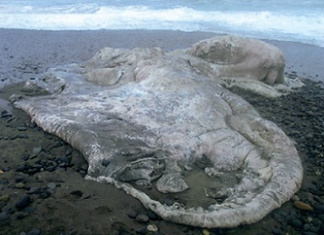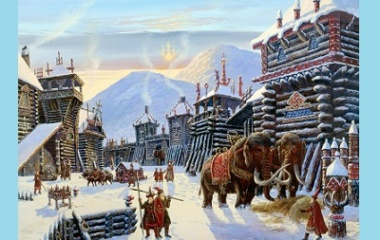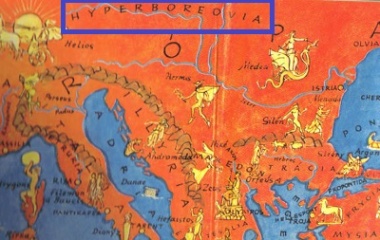- Pronunciation: hahy-per-bohr-ee-uh
- Origin: Greek
- Location: North of the Riphean Mountains
- Role: Mortal Land
- Associated Gods: Apollo
- Associated Regions: Ural Mountains, Swiss Alps, Arctic Circle
What Is Hyperborea?
Hyperborea is the mythical land of the people “beyond the North Wind” in Greek lore. It is mentioned by the Greek historian Herodotus as a continent-bound land from Egyptian legend, bordered by the river Oceanus. Eridanos was the main river that flowed through it, home to white swans and lined with poplar trees that would weep amber. At one point, it had been blessed with eternal spring, resulting in a double harvest of grain per year, with most of the countryside covered in forests called the Garden of Apollo. When it was destroyed by ice, its people were believed to have migrated to lands in the south. According to Greek legend, the land of Hyperborea is a place of total perfection, with sunlight 24 hours a day. The people never suffered from disease or old age, nor did they have to labor or fight in any wars or battles.
Location
Hyperborea is believed to have been far north of Thrace, and in modern times would be considered to be located within the Arctic Circle. The actual location of Hyperborea is a mystery, however, and according to the Greek Poet Pindar, the road to the Hyperboreans could not be found by ship or on foot.
Several legends point to the snow-covered Riphean Mountains, next to the Black Sea, as the location of Hyperborea, far beyond the realm of Boreas, ruler of the North Wind. Different philosophers and poets have placed Hyperborea in different areas, adding to the mystery. Homer believed Boreas to be in Thrace, claiming that Hyperborea was located in the region of Dacia, now an area north of the Balkan Mountains. Aristotle wrote that the Riphean Mountains were on the border of Scythia, with Hyperborea being even further north. And Hecataeus of Abdera believed that Hyperborea was in the area of what is now called Britain. Although Hyperborea is also described as being north of the Celts, at the time, Celtic society was in Europe and only became restricted to Britannia after the death of Christ. In Hecataeus’ account, griffins inhabited the peaks of the mountains near Hyperborea, and the valleys surrounding them held the one-eyed tribe of Arimaspoi.
People
The Greeks believed that Boreas, god of the North Wind, lived in Thrace, and may have been part of a Celtic tribe, such as the Helvetii. They built a sacred province dedicated to Apollo and adorned the temple they constructed with spherical offerings; some scholars believe this temple to be Stonehenge. The people of Hyperborea could have been either of Gaulish origin (modern-day France) or possibly Northern European (Scandinavian) descent. One of the most legendary of the Hyperborean people was a healer known as Abaris, who is described by Herodotus as a sage and priest of Apollo.
History
Hyperborea was best known as a land where people never grew old, were blessed with disease-free bodies, and were untouched by war and hardship. Apollo’s priests ruled Hyperborea as a theocratic society. The three kings who ruled it in his honor were the Boreades, sons of the North Wind, Boreas.
The Hyperboreans worshipped Apollo, who was believed to live among them. They would pack mysterious gifts in straw and pass them from one tribe to the next until they completed the journey to the temple on Delos.
Several notable myths and figures arose from Hyperborea, including great healers, founders of shrines, and trials of mortals set upon them by the gods.
Abaris the Healer
Abaris the Healer traveled around the world on a magical arrow meant to symbolize Apollo, eating no food as he journeyed, and performing miracles wherever he went. The arrow he flew on was the same arrow Apollo used to slay the Cyclopes, and it had been hidden beneath a Hyperborean mountain before being found by Abaris. He practiced healing of the soul as well as the body through incantations, and also had a gift for prophecy. He wore simple Scythian clothing and was held in high regard in Greece for his honesty and simplicity. Abaris learned his healing skills after fleeing a plague at Caucasus in his homeland of Hyperborea. With what he learned from the experience, he was able to purify Sparta and Knossos and several other cities. His ability to reason and his persuasive manner helped him to steer a former tyrant, Phalaris, towards a virtuous life after a long discussion of divine matters. Abaris was able to read omens and predict future events by examining the entrails of animals, and his deeds are mentioned in the Scythian Oracles.
The Mortal Sons of Gods
Several of the mortal children of the gods visited the land of Hyperborea. Phaethon, in an attempt to prove to his friends he was the son of Helios, tried to drive the sun chariot. He could not control it, however, and, given no other choice, Zeus struck him down to prevent the scorching of the Earth. In flames, his body fell into the River Eridanos. The Helidaes, his sisters, transformed into amber-weeping poplar trees in their grief over Phaethon, and his friend Kyknos was transformed into a swan. The Hyperboreans, when they began to reach old age, would leap into the lake created by Phaethon’s fall, and would themselves become white swans in commemoration of the tragedy.
Perseus, who was the son of Zeus, traveled to Hyperborea. Here he went in search of the Nymphs who were the guardians to the gods’ treasures. He was entertained by the people of Hyperborea and would go on to find the Graiai, who were swan-bodied crones who knew the location of Medusa. Heracles, a descendant of Perseus, would also make this journey in search of Artemis’ golden-horned deer. He would return to Hyperborea searching for the golden apples of Heserides, and also to find Atlas.
The people of Hyperborea are mentioned in the founding of the Olympic games, when Heracles began a festival for Zeus’ honor he made a pilgrimage to Hyperborea to take sacred wild olives for the shrine.
Founders of Shrines
Leto, a female Titan, traveled to the island of Delos from Hyperborea along with her pack of wolves to give birth to Apollo, with aid from Eileithyia who came from the northern realm. The Hyperboreans sent five men and several female priestesses as pilgrims to the island to form a shrine, but the maidens were raped and killed, which caused the Hyperboreans to end the pilgrimage and choose to deliver offerings and messages through neighboring tribes instead. The oracle of Apollo at Delphi is another major shrine in Hyperborea. The Hyperboreans made the temples located at the shrine from beeswax and feathers. At the time the Gauls attempted to sack the temple, phantom spirits of the pilgrim prophets appeared and chased the army from Hyperborea.
Current Influence
Modern-day Scandinavians have been frequently identified with the Hyperboreans, especially in 17th century Sweden where the Goths believed the Scandinavian Peninsula to contain both Atlantis and the land of Hyperborea. Western European culture also self-identifies with the Hyperboreans, through European scholars in the 19th century in works of literature. To this day, the term Hyperborean is used to refer to people who inhabit a cold climate and is also associated with the languages of peoples indigenous to the Arctic Circle.










